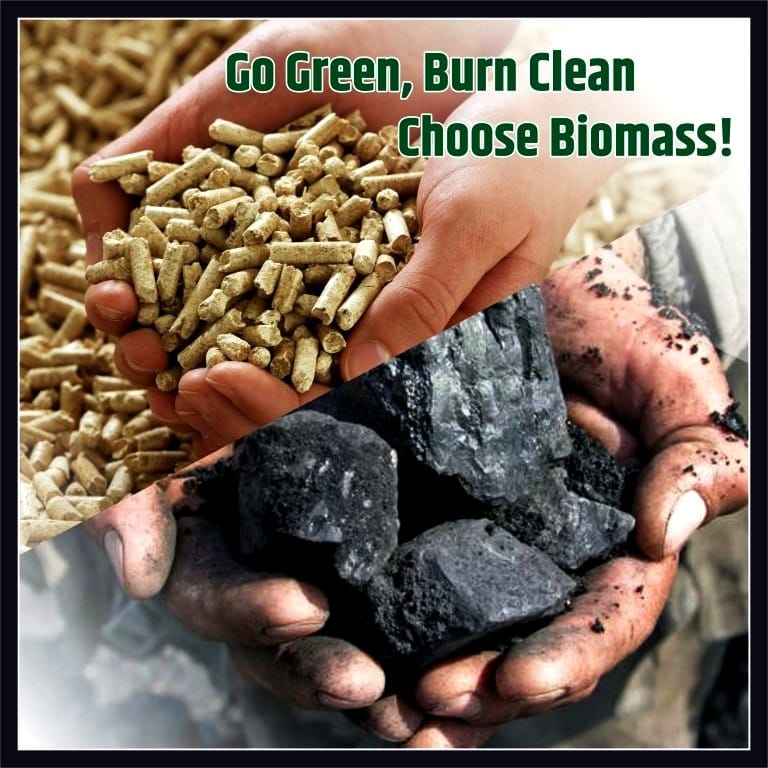COAL VS BIOMASS PELLETS-WHICH FUEL IS BETTER FOR INDUSTRIES.

Introduction
As of 2025, with increased global focus on sustainability and renewable energy, business establishments are being presented with a callous question: Do we stick with coal or go for biomass pellets? This is now the single most important comparison to make in energy choices across thermal power plants, cement plants, food processing plants, and boilers.
Let’s put coal vs biomass pellets on a comparison table based on parameters such as cost, energy efficiency, emissions, availability, and government policies to facilitate your informed decision.
What are Coal and Biomass Pellets?
Coal: A fossil fuel that is non-renewable, made over millions of years from vegetation. Coal is conventionally utilized in industry for high-heat burning.
Biomass Pellets: Pressed organic substance, usually produced by agricultural residues, sawdust, bagasse, rice husk, wood chips, and forest wastes. Biomass pellets are carbon-neutral, renewable, and cleaner fuel compared to fossil fuels.
The choice between coal and biomass pellets for industrial fuel in 2025 hinges on several factors, including cost-effectiveness, environmental impact, and operational suitability.
1. Cost-effectiveness
- Coal: Generally less expensive per unit of energy, but price can fluctuate with market demand.
- Biomass Pellets: Priced competitively, especially considering potential cost savings in boiler operation and maintenance due to cleaner combustion and lower ash production.
2. Environmental impact
- Coal: High carbon emissions, sulfur content, and ash production contribute to air pollution and environmental damage.
- Biomass Pellets: Considered carbon-neutral (when sustainably sourced), lower sulfur content, significantly less ash (which can be used as fertilizer), and reduced air pollution compared to coal.
3. Suitability for operations
- Coal: Established infrastructure, higher calorific value (5700 to 6200 Kcal/Kg vs. 4000 Kcal/Kg for pellets). Requires proper management of coal yard and ash disposal.
- Biomass Pellets: Consistent quality (moisture content below 6% ensures better burning), easier to store and transport, and automated feeding systems simplify boiler operations.
Additional factors to consider
- Boiler Efficiency: Optimized combustion with biomass pellets can result in higher thermal efficiency (around 80-85%) compared to coal boilers (around 65%).
- Co-firing: A viable option to gradually transition away from coal, combining coal with biomass pellets to reduce emissions and potentially improve combustion efficiency.
- Regulations and Incentives: Increasing government support for biomass energy (e.g., subsidies, carbon credit benefits) makes biomass a more attractive option.
- Calorific Value (Energy Output)
Fuel Type\tGCV (Gross Calorific Value)
Coal (Indian)\t3,500 – 5,500 kcal/kg
Biomass Pellets\t3,800 – 4,600 kcal/kg
Torrefied Biomass\t4,800 – 5,200 kcal/kg
✅ Conclusion: Torrefied biomass pellets can almost equal the calorific value of coal with cleaner burning.
- Cost Comparison (INR/ton)
Fuel Type\tPrice Range (2025)
Coal\t₹8,000 – ₹12,000 per ton
Biomass Pellets\t₹6,500 – ₹9,000 per ton
Torrefied Pellets\t₹9,000 – ₹12,000 per ton
✅ Biomass pellets provide stable and low-cost pricing, particularly with domestic production and government incentives.
- Emissions and Environmental Impact
Parameter\tCoal\tBiomass Pellets
CO₂ Emissions\tHigh (non-renewable)\tNeutral (renewable)
SOx & NOx\tHigh\tVery Low
Ash Content\t15–35%\t1–3%
✅ Biomass pellets significantly lower carbon emissions, ash handling costs, and particulate pollution.
- Boiler Compatibility
Coal boilers demand high ash handling and chimneys with ESPs.
Biomass pellet burners and multi-fuel boilers are space-saving, low-maintenance, and easy to retrofit.
✅ Several industries are switching to biomass-compatible boilers or employing front-fire pellet burners such as FABON’s Industrial Pellet Burner for easy retrofits.
- Storage and Handling
Fuel Storage Handling
Coal Bulky, requires large space Causes dust & pollution
Biomass Pellets Compact, moisture-sensitive Cleaner and odor-free
✅ Biomass pellets provide simpler logistics and reduced spillage losses.
- Government Policies & Subsidies (India – 2025)
India is phasing down coal utilization under National Bio Energy Mission.
Maximum of 35% capital subsidy for biomass-based energy plant and machinery.
Thermal Power Plants are required to co-fire 5-10% biomass pellets with coal.
✅ Carbon credits, RE certificates, and tax benefits are available to industries utilizing biomass.
- Availability & Sustainability
Coal: Finite, imported coal prices are erratic.
Biomass Pellets: Obtainable locally from agro-waste, wood waste, sawdust, bagasse — readily available throughout India.
✅ Biomass promotes local economies, circular economy, and utilization of agricultural waste.
Conclusion: Biomass Pellets are the Future
Though coal has always been the industrial norm, biomass pellets are set to become the cleaner, greener, and sustainable option in 2025. They cut emissions, decrease operational expenses, and are in line with environmental regulations.
FABON Engineering Pvt. Ltd., Nashik, Maharashtra, provides:
High-performance biomass pellet burners
Wholesale pellet making lines
Retrofitting solutions for coal boilers as per customers’ specifications.
???? Reach FABON Today for:
✅ Installation of biomass pellet plant
✅ Pellet burner for boiler installation
✅ Guidance on government subsidy
✅ Cost-benefit ROI analysis consultation
Visit: www.fabon.in
Email: sales@fabon.in
Call: +91-9370999191

